Why Marketers Should Be Repurposing Their Content
You should be repurposing content — and we have the data to prove it. Brush up on the latest content repurposing statistics to level up your strategy.

As a marketer, you spend a whole lot of time and effort creating content, whether that’s videos, social media posts, or written content. For all the work, you want that content to stretch as far as possible.
That’s where content repurposing comes in. Content repurposing is taking existing content, whatever form it’s in, and reusing it across multiple platforms for multiple purposes. This is sometimes also referred to as content atomization and it should be a standard part of your content strategy.
That could look like repurposing video content by cutting a long-form YouTube video into short segments for TikTok, or turning a blog post into a series of infographics, or flipping a thought leadership post on LinkedIn into a script to become a video, or even simply translating a video for an audience in a different market.
The biggest benefit of content repurposing is that your content’s lifespan is expanded, creating a better return on investment for each video, blog, or post. It saves the effort and expense required to make a totally new piece of content each time you want to post something fresh to a channel or your website.
Let’s take a closer look at why content repurposing is so popular among marketers, the importance of video in particular, some ideas for how you repurpose your own content as part of your own content marketing strategy, as well as plenty of content repurposing statistics.
Why content repurposing is so hot right now, with content repurposing statistics
If you’re looking for creative ways to get more value out of existing content, you’re in good company. According to a survey from ReferralRock, 94% of marketers they asked had repurposed content for different channels and mediums. And that 6% that isn’t already repurposing content? Well, they’re actively thinking about doing it in the future.
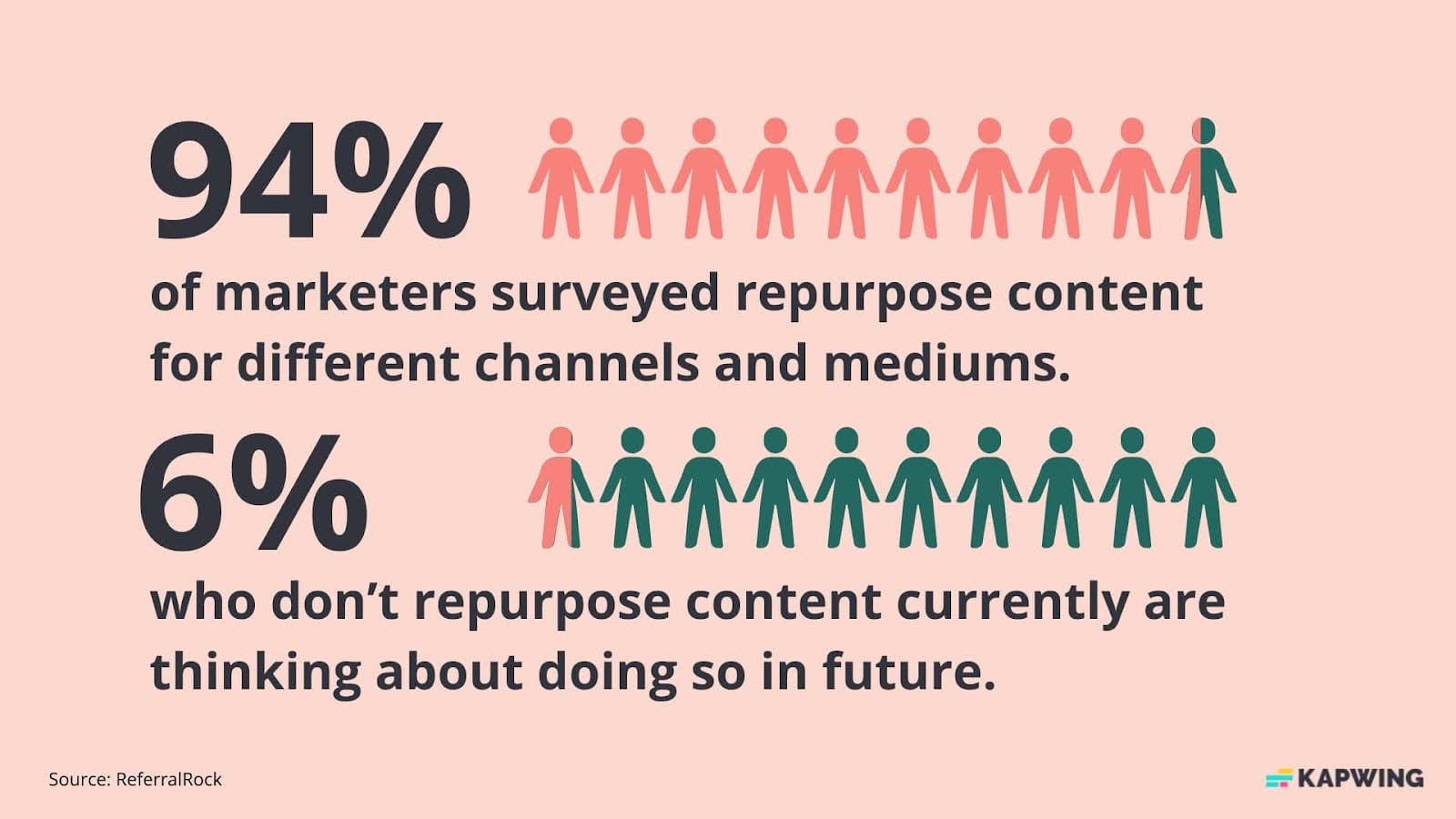
There are a few reasons why content repurposing is a winning marketing strategy and a part of content creation for most marketers.
The rise of video
A huge reason why marketers are so interested in content repurposing is the meteoric rise of video on the internet. Video is now a non-negotiable pillar of any good marketing strategy.
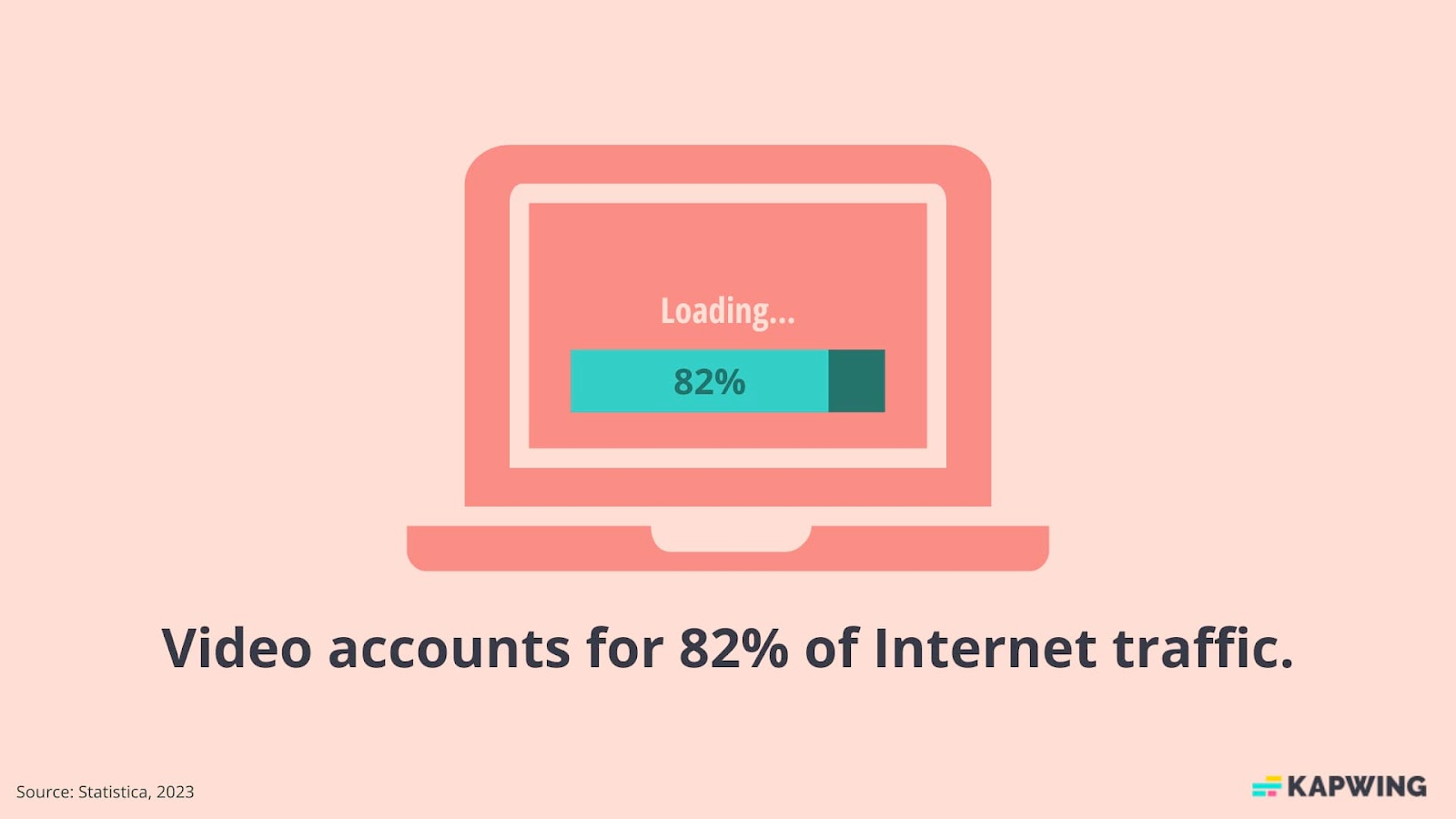
Consider that a staggering 82% of global internet traffic came from video in 2022, according to Cisco. As well, people consume an average of 17 hours of online video every week. Add to that the fact that in 2023, 91% of people said they wanted to see more online videos from brands, which is up from 88% in 2022.
Marketers have certainly taken notice of this trend. According to an annual report from Wyzowl, video marketing is at an all time high with 91% of businesses using video as a marketing tool in 2023.
There are now also more places than ever to post videos. Beyond long-form videos on YouTube, there’s been huge growth in short videos on platforms like TikTok, Instagram, and even on YouTube itself with Shorts. In fact, according to Sprout Social, 66% of consumers say short-form video is the most engaging type of social media content.
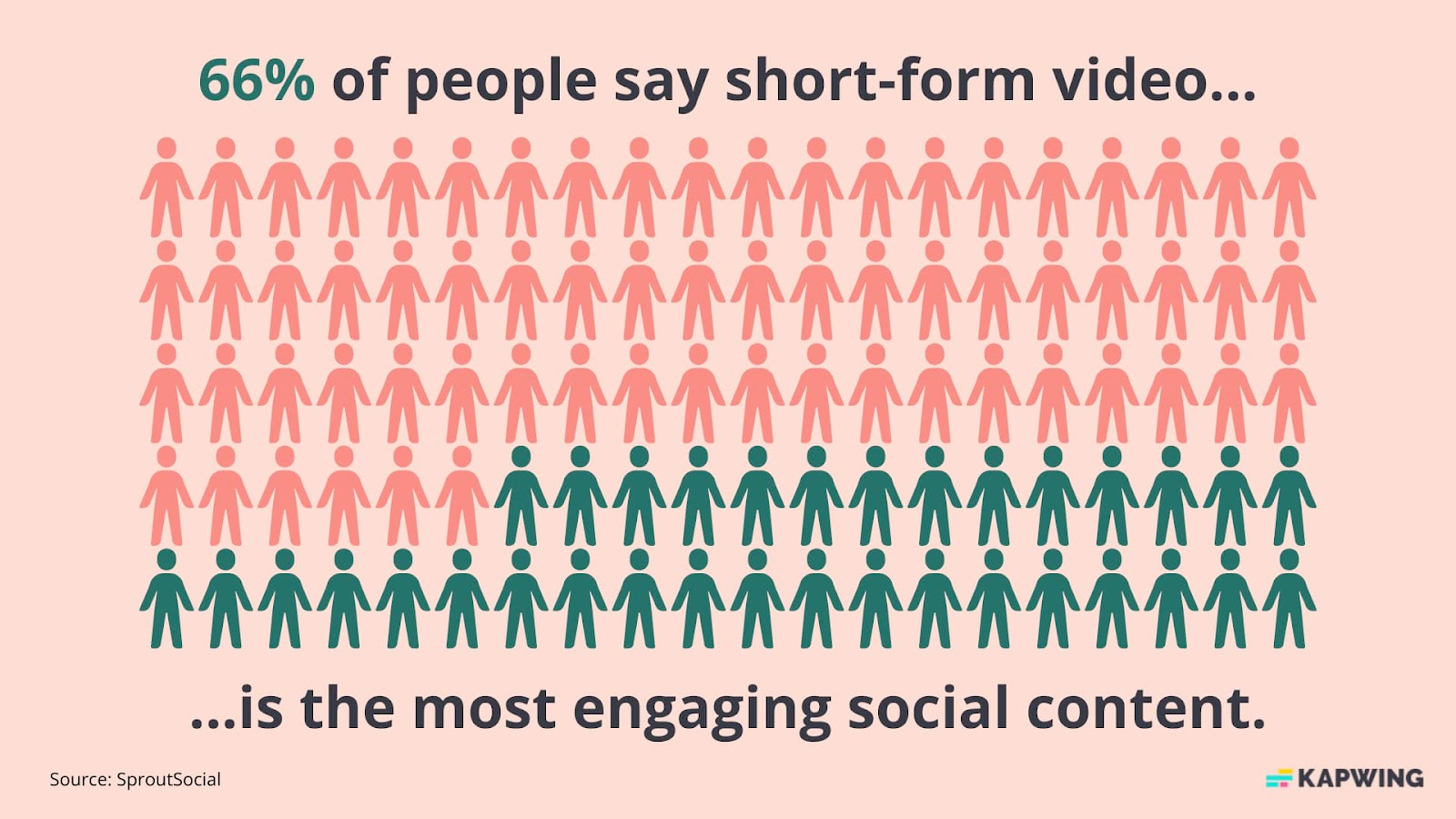
What that means for marketers is that demand has never been higher for video. That also means a high demand for resources to make those videos. A two-minute marketing video can take four to eight weeks to produce. According to HubSpot, 65% of marketers say the production stage — including filming, lighting, and audio — is the most expensive part of the video creation process. And 38% said pre-production — ideation, writing, and casting — is the most time-consuming stage.
With all these platforms demanding daily content, you can see how that timeline just isn’t going to work. This is where content repurposing comes in.
Spending weeks to create a piece of video content that’s only posted one time isn’t efficient at all. But, if you can take a single video and cut it into a series of short-form videos, social media posts, and some blogs, then you’re maximizing your return on investment. You can also work the other way, turning blog posts, infographics, and reports into video content.
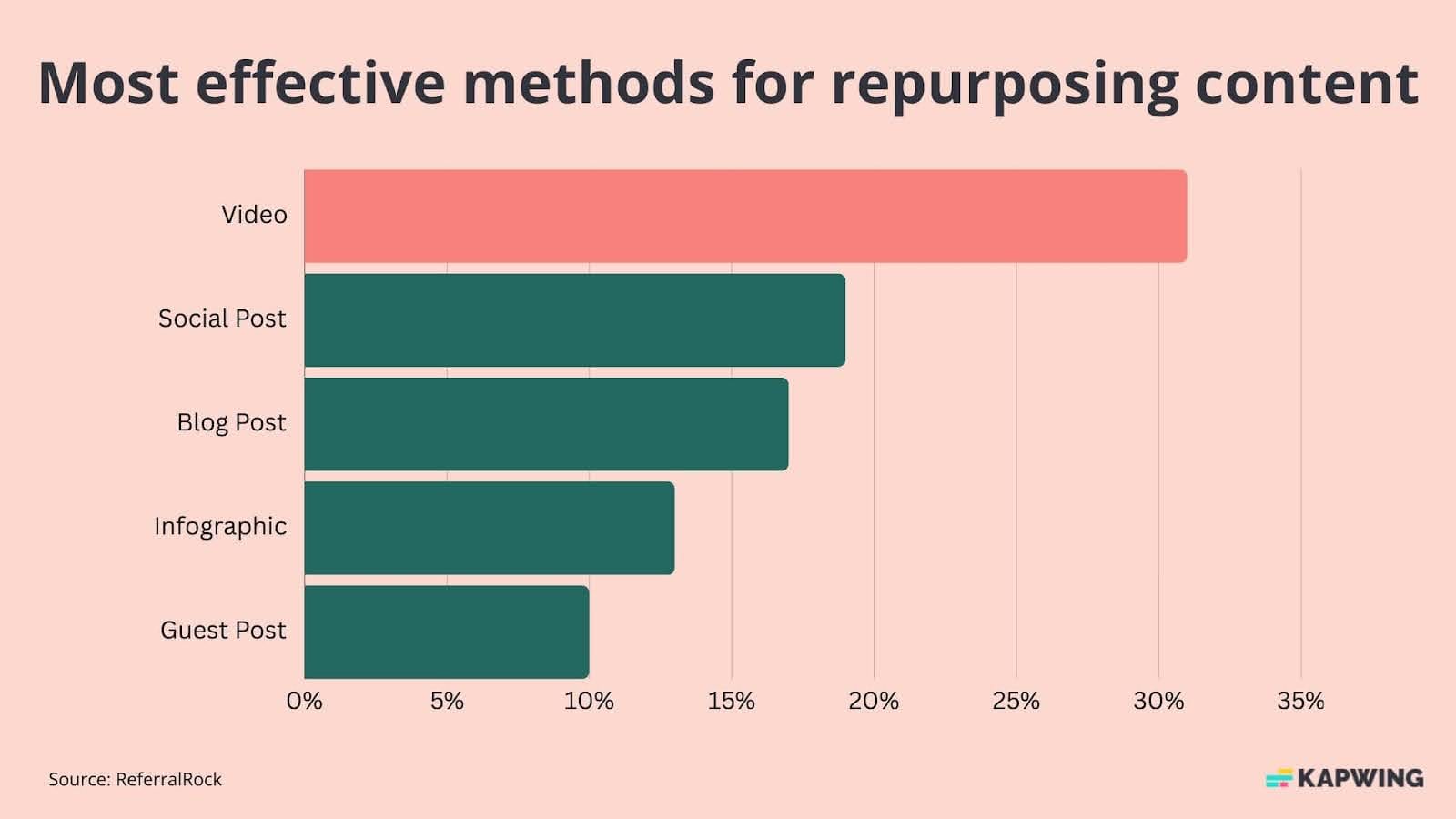
Going back to that ReferralRock report, 31% of marketers said creating video is the most effective method for repurposing existing content.
Repurpose content to save time and money
We know that repurposing content will boost your video marketing, but what are the other benefits of this strategy? Content repurposing statistics show that marketers agree that this strategy saves money and time for marketers, as well for improving engagement.
ReferralRock asked marketers which generates the best engagement, leads, and conversions: creating new content, updating existing content, or content repurposing for different mediums and channels. Repurposing content won, with 46% of marketers saying it had the best results.
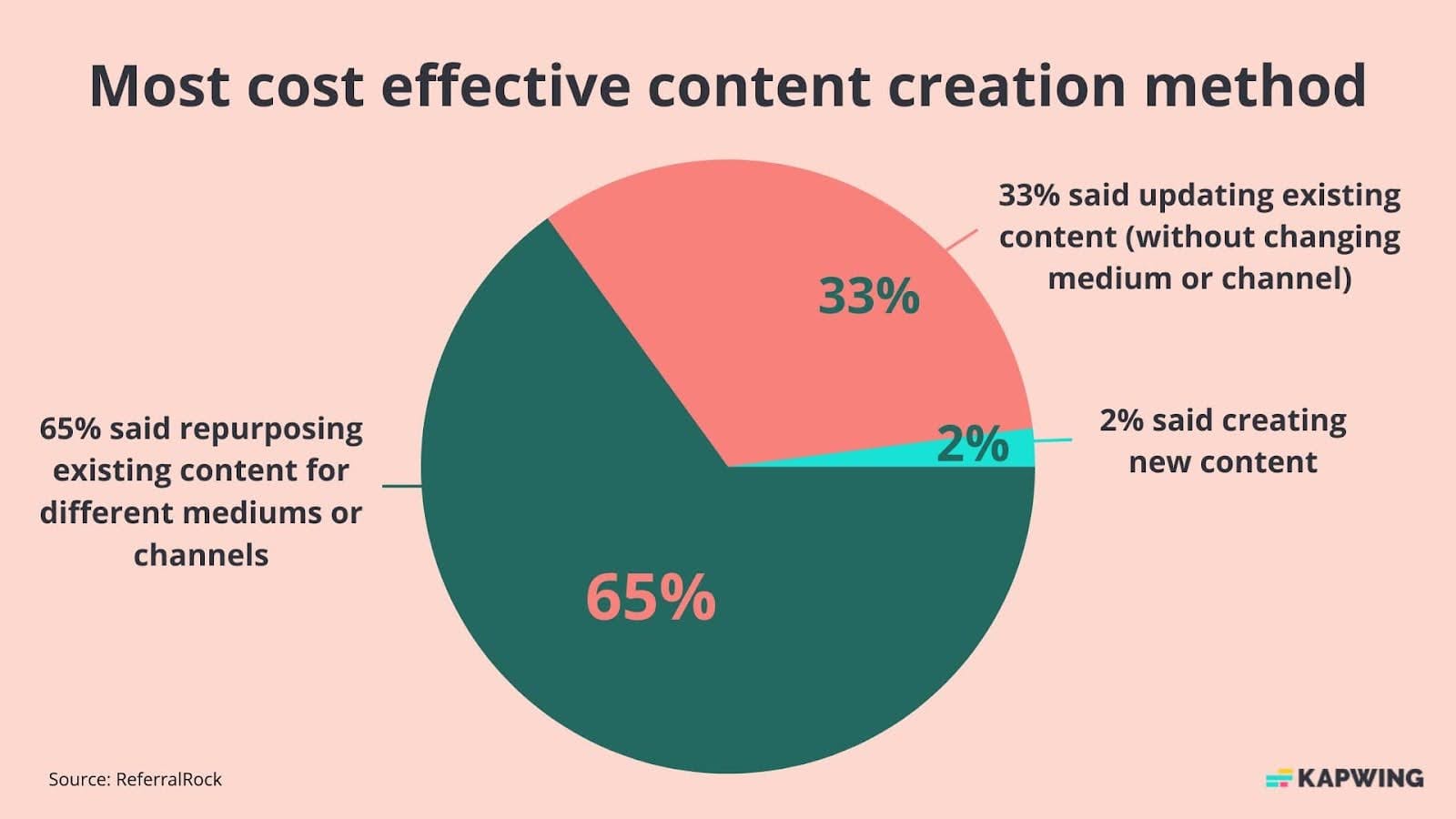
Marketers also agreed that content repurposing was the most cost-effective strategy, with 65% saying so. By comparison, only 2% said the same about creating new content, and 33% picked updating existing content.
They also said repurposing content was the most effective strategy in terms of making the best use of your time. In the survey, 48% of marketers said repurposing content was best based on the time it takes to accomplish, but only 6% said the same about creating new content.
The surveyed marketers named a few other reasons why content repurposing is beneficial. 31% said content repurposing helped increase engagement with their content, 21% said content repurposing helped increase brand reach and awareness, and 15% said it helped increase web traffic.
What kinds of formats are marketers repurposing?
Now we’ll look at exactly how you can repurpose content, whether you’re starting with video or written content formats.
Ways to repurpose video content
We’ve already talked about how time-consuming it is to produce video content. Between coming up with ideas, getting those ideas approved, the planning process, and actually filming and editing a video, you’re looking at what could be weeks’ worth of work.
That effort and careful planning is certainly necessary to make effective, high-quality content, and the end result is worth it. Make the most of that content with these ideas for content repurposing.
Webinars
The use of webinars is on the rise, especially for B2B content marketing teams. According to Search Engine Journal, 54% of B2B professionals watch webinars on a weekly basis. As well, viewers watched three times more webinars in 2020 compared to 2019.
Webinars are live events and in order to repurpose them, it’s crucial that you’re also keeping a recording. That recording can easily be flipped into multiple content formats.
Tip: A local recording is best if you’ll be repurposing your webinar content, as you’ll get higher quality video. There are plenty of streaming and video podcasting software that double as remote recording studios that we recommend.
First, you can take clips from the webinar to turn into short-form video. Look for insightful quotes or slides that can stand alone as a fun fact or piece of advice. TikTok, Instagram Reels, and YouTube Shorts are all primary destinations for short-form video, but video clips also perform well on LinkedIn.
If you post a full, hour-long webinar on LinkedIn, very few people are likely to click and watch the full video. However, if you create short, teaser clips you’ll see higher engagement. Watching these clips may even catch someone’s interest enough to then seek out the full webinar.
Webinars tend to have a slow start with introductions, so the clips you create should do the opposite of that and have an immediate hook.
Another option with webinars is to turn them into written blog posts. Some people would rather read an article than watch a video, especially if they’re short on time. Try creating a blog post that summarizes the webinar and highlights key quotes, insights, and graphics. One quick way to do this is by generating a transcript of the webinar. This makes it easier to convert video into a blog post.
Finally, webinars are a perfect starting-off point for creating infographics. According to ReferralRock, infographics are the number one format marketers make when they repurpose content with 69% saying they do it. Take an interesting statistic and flip it into an infographic that can be shared on social media platforms, or even animate it to create a short video.
Video podcasts
First of all, you are making videos of your podcasts, right? Because you should be.
Although podcasts are traditionally audio content, podcasters are increasingly releasing video versions of their episodes. According to research from Morning Consult, 46% of avid podcast consumers actually prefer video podcasts to audio-only. Gen Z and millennials especially prefer to watch podcasts rather than just listen.
Once you have your podcast as a video, you can cut it into shorter clips to share on social media. TikTok in particular is a fantastic place to post podcast clips. On TikTok, the tag #podcast has 96.9 billion views on TikTok, and #podcasts has 4.6 billion views. Many of these clips have gone viral on the platform.
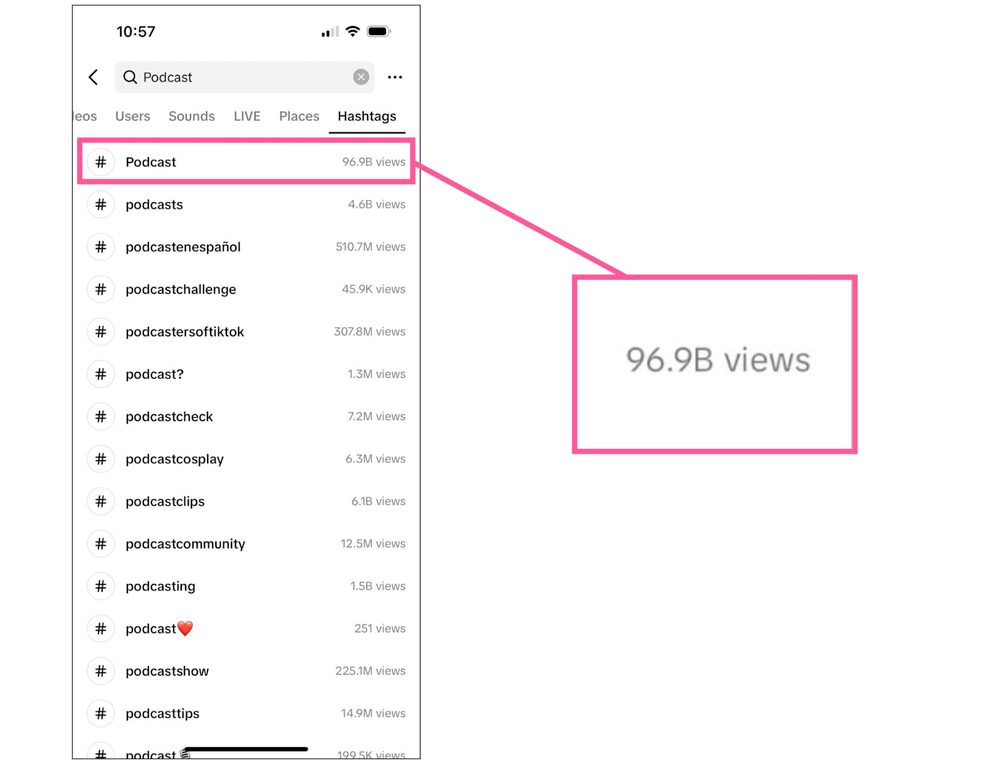
Like with webinars, you want to look for great moments. If the destination for the clip is TikTok, Instagram Reels, or YouTube Shorts, search for moments that are particularly entertaining, as that’s what people are looking to watch on those platforms.
The advantage here is that you can reach a new target audience who may not be aware of your podcast, or may not even be podcast listeners yet.
Also consider turning your video podcast episodes into blog content by transcribing it. You can do this even if your podcast is just audio content.
Long-form videos
Whether you’ve created a long-form video for YouTube, Facebook, LinkedIn, your website, or elsewhere, it can be repurposed into short-form video. One method is to cut a long-form video into short clips, under 15 or 30 seconds, for use as TikToks, Reels, Stories, or Shorts. Short-form video is a smart move for both your business and for viewers.
According to HubSpot’s State of Marketing 2023 report, marketers agreed that short-form videos are the marketing trend with the highest return on investment — more than influencer marketing, direct messaging, or even search engine optimization. As well, 90% of marketers who use short-form videos plan to either maintain or increase their use in their marketing strategies in 2023.
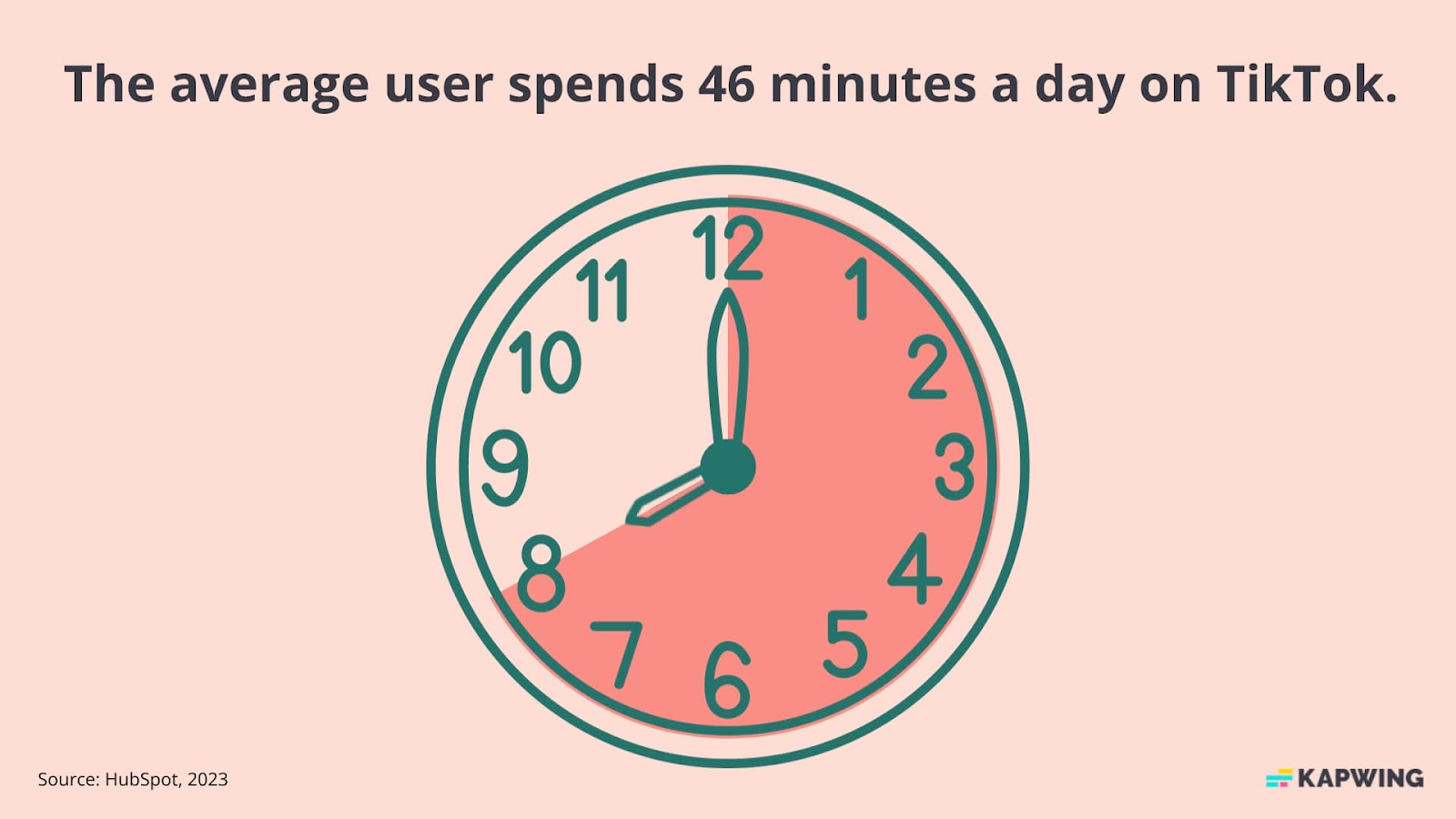
The most popular destination for short-form videos is TikTok, with 42% of marketers already using it and 56% planning to increase their investment in TikTok in 2023.
Long-form video, similar to webinars, can also be flipped into blog posts or infographics.
Ways to repurpose a blog post
Like video, a high-quality blog post takes time and investment to create. According to a survey from Orbit Media, the average blog post takes three hours and 51 minutes to write. A blog post with in-depth research or interviews can take much longer, not to mention the expense to have it created either in-house or by a freelancer.
So again, just like with videos, repurposing that blog content stretches the life of a post and creates a higher turn on investment.
Let’s look at what you can create by repurposing a blog post.
Long-form video
All the great information found in a blog post makes an excellent basis for a long-form video.
While you could do this with simple b-roll, graphics, and narration, the most engaging format would be to have a host on camera to present the information in a blog post. Don’t just have them read the blog post though — rewrite it into a conversational video script. You can then add infographics and b-roll to flesh out the video and keep it interesting for viewers.
For example, a blog post of statistics on a particular topic can be repurposed into a listicle-style video, like “The ten most interesting facts about (your topic).” Or, if your blog post is a tutorial, you can create a how-to video following along with the instructions in the post.
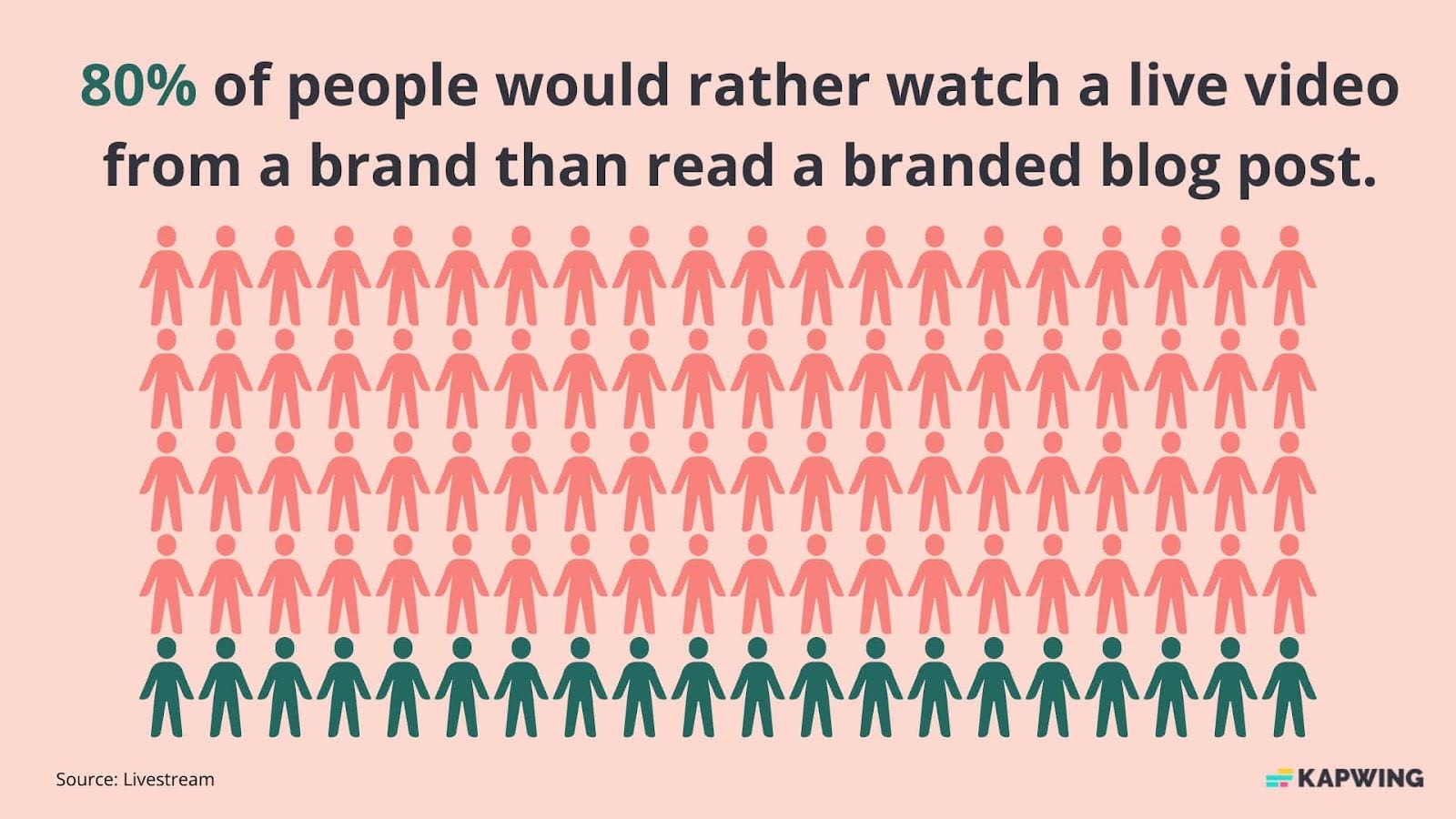
Also consider hosting the video first as a livestream. According to Livestream, 80% of people would rather watch a live video from a brand than read a blog post.
Multiple short-form videos
Higher word-count, authoritative blog posts can contain enough info to inspire a series of short-form videos.
Look for interesting sections that could become a quick fact or insight. Short-form videos actually lend themselves well to a simple b-roll and captions format with some music. Or, if your blog post is a tutorial, do a sped-up version as a short-form video or create a separate short-form video for different sections.
These clips can then be posted to social media, such as TikTok, Instagram, Facebook, or YouTube.
Infographics for social media posts
Again, content repurposing statistics show the infographics are the number one type of creative made when flipping existing content.
Look through a blog post for interesting statistics and create infographics sized for social media posts like on Instagram, such as with a carousel post, on X, and on LinkedIn. These can act as teasers for the blog post itself and encourage clicks.
Content repurposing tips
Here are some general tips to keep in mind when you repurpose content as part of your content marketing strategy.
Check analytics and search engines
You might have a lot of content to choose from when it comes to selecting content to repurpose. Don’t make it guesswork — have a look at your analytics, whether internally or with Google Analytics, to determine which content to repurpose.
Look for content, whether that’s videos or blog posts, that have already made an impact. A blog post with particularly high traffic is more likely to have statistics or insights that would work well as a standalone video or graphic. If you’re starting with a long-form video, pay attention to where viewership dropped off, or if there are any moments that people have commented on. If everyone is commenting on a funny moment in your video, that’s a perfect moment to clip for TikTok.
Repurposing content that didn’t receive many views is riskier because you may be wasting effort, but on the flip side you can try to drive new traffic to that content by repurposing it. It could be that in a new format, it finds a new target audience.
Look for evergreen content for content repurposing
Evergreen content is media that remains relevant long after you first publish it. An eyeliner tutorial is evergreen, for example, but a blog post about sales for June 2023 isn’t.
You want to look for evergreen content to use for content repurposing because whatever you create with it will have a longer shelf life. Even ancient blog posts can be repurposed now and again in the future if it's evergreen.
A good way to check if the topic of the content you want to repurpose is with keyword research. Using a keyword research tool like Ahrefs, or even something simple like Google Trends, you can check the search volume for a particular topic. If the volume is high or growing, you’re good to go. If the topic is in decline, you may want to pick something else.
Consider the platform
Simply reposting the same piece of content to multiple platforms without changing it is a terrible way to repurpose content. Each platform and medium is different and needs to be treated differently.
For example, instinct probably tells you that posting a webinar as 60 one-minute long TikToks is an awful idea. The same is true of simply reading off a 2,000-word blog post as a video.
Shorter video content needs to be conversational and fun, especially if it’s going on a short-video platform like TikTok or Instagram. Content repurposing for LinkedIn should be of interest to a professional audience, but still attention-grabbing. A blog post written from a long-form video should have a different tone, with more information to flesh it out.
Along with that, don’t skip crucial steps like making sure to appropriately resize video for different platforms when repurposing content.
Repurpose your existing content and improve ROI
Your content marketing strategy will inevitably be strengthened if you include repurposing content.
Whether you’re working with old blog posts or videos, you can repurpose content into new formats for posting on social media, short-form video apps, or wherever else your content lives. When you repurpose content, you’re expanding the usefulness of each piece of content, which in turn improves your return on investment.
Content repurposing is popular for a reason, so when planning your content creation, consider how you can turn one piece of content into many.









